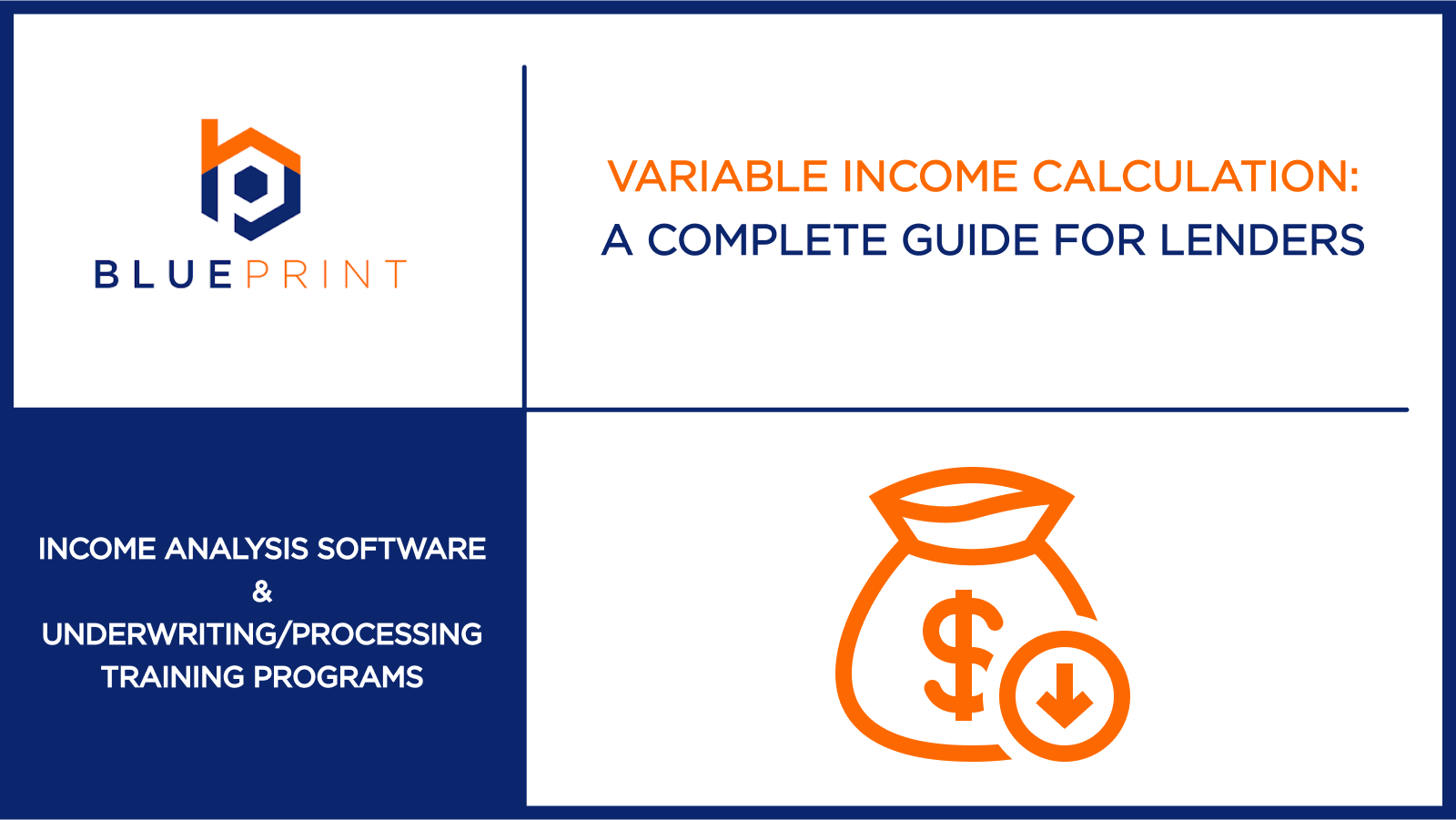Variable income presents unique challenges in mortgage underwriting due to its fluctuating nature. Unlike fixed salaries, this type of income can vary over time, making it harder to assess stability and predictability. As a result, lenders must apply careful analysis and follow consistent documentation and calculation practices to determine whether variable income can be used to support a borrower’s mortgage application.
In this guide, we’ll walk through how lenders evaluate variable income, including how they assess trends, apply averaging methods, and align with applicable agency guidelines.
Main takeaways from this article:
- Understanding how commissions, bonuses, overtime, and self-employment earnings differ from regular salaried wages is crucial in verifying a borrower’s loan eligibility.
- Gathering comprehensive records, such as pay stubs, tax returns, VOE forms, and bank statements, is critical for a thorough assessment.
- Each lending organization (Fannie Mae, Freddie Mac, FHA, VA, USDA) has specific rules for variable income calculations, making it essential to stay current with guidelines.
- Using platforms like IncomeXpert can support lenders by automating data capture, verifying compliance, and flagging potential errors in variable income analysis.
What is variable income?
Variable income refers to earnings that are not derived from a fixed salary. Instead, such income can change based on factors like sales volume, project-based work, or company performance. While many people associate variable income with commissions, bonuses, and overtime, it can also include self-employment income, interest, dividends, or any other non-fixed income source that must be averaged over time.
Because variable income can fluctuate from month to month or year to year, lenders must perform in-depth analyses of its stability and continuity. They analyze the stability of variable income by examining historical patterns and external factors over a period of 12 months or longer for inconsistent earnings.
Common examples of variable income

Understanding the different types of variable income is essential for lenders assessing a borrower’s financial profile. Below are some common examples of variable income that borrowers may present:
Commission-based income
Commission-based income is often linked to sales roles, where earnings fluctuate depending on the number or value of deals closed. If a borrower relies primarily on commissions, lenders usually require at least two years’ history to confirm that commissions constitute a stable and ongoing source of money.
Bonus income
This income is frequently tied to an individual’s work performance or the company’s financial results. Because bonuses can vary from year to year, lenders look for a pattern of consistency or growth. They will also question whether bonuses are likely to continue, especially if there has been a shift in the borrower’s role or the company’s profitability.
Overtime pay
This additional pay can greatly boost monthly earnings, but it is not always guaranteed. To count overtime as part of the qualified income, lenders require evidence that it is both frequent and expected to continue. Regular analysis of pay stubs and year-to-date records is usually performed to establish an overtime trend.
Self-employed income
Self-employed earnings can encompass income from sole proprietorships, partnerships, or corporations. Since self-employed income often fluctuates based on market conditions or business performance, lenders look at multiple years of tax returns to verify ongoing stability. It is wise for self-employed individuals to maintain a robust emergency fund to navigate periods of lower income.
In certain cases, lenders may request a profit and loss statement (P&L) or bank statements to assess cash flow.
Freelance or gig economy income
If a borrower earns income through short-term contracts, independent work, or app-based platforms, it may be classified as freelance or gig economy income, depending on how the work is sourced and reported. Some examples of income for these positions would be ridesharing, home rentals, and food delivery. It is prudent for those with freelance income to build a substantial emergency fund to cushion against income variability.
Lenders may request either an income statement or a 1099 form to confirm the borrower’s income information. They might also ask for bank statements to ensure that the income is legitimate and consistent.
What are the guidelines for verifying fluctuating or variable income?
When it comes to verifying fluctuating or variable income, lenders must follow some general guidelines to ensure accuracy and compliance with various regulations. Here are some key guidelines to consider:
- Establish a sufficient history of variable income: Most programs look for at least 12 months of documented variable income, though 24 months is preferred. This history allows underwriters to identify earnings patterns and confirm that they reflect a borrower’s usual work situation.
- Confirm ongoing likelihood of continuance: In some cases, a Verification of Employment (VOE) may include comments on whether commissions, bonuses, or overtime are expected to continue. Freelance or self-employed borrowers should provide contracts or statements of earnings that confirm ongoing engagements.
- Collect comprehensive documentation: A thorough paper trail ensures that underwriters can compare different records for consistency. Key documents include tax returns, year-to-date and year-end paystubs, verification of employment and income received, bank statements, invoices and contracts, and profit and loss statements.
- Determine income stability: Evaluate whether income is trending upward, roughly stable, or declining. An upward or stable trend is generally more favorable. If variable income declines are observed, underwriters may request a written explanation and supporting evidence. Acceptable explanations, such as a temporary medical leave, can support a conclusion that earnings might recover.
- Follow agency-specific requirements: Be familiar with specific guidelines from lending agencies like Fannie Mae, Freddie Mac, FHA, VA, and USDA. Each has unique requirements for variable income verification that lenders must comply with, including rules around averaging income and documentation standards.
- Document the underwriter’s rationale: Underwriting files often include a narrative on how the final figure was reached, including any special considerations or exceptions. Lenders frequently employ checklists to confirm that all relevant documents are included. Any items left out or noted as “not applicable” should be addressed.
Key documents for calculating variable income

To calculate variable income properly, lenders rely on the documents listed below. Multiple sources give lenders a more complete understanding of the borrower’s overall financial profile.
- Tax returns: Individual and business tax returns (if applicable) reveal the borrower’s net income, deductions, and annual income trends. Generally, two years’ returns are requested for consistency.
- Year-to-date paystubs: These paystubs demonstrate the borrower’s recent earnings and patterns in commissions, bonuses, or overtime. They help identify any growth or decline in variable income in the current year.
- Year-end paystubs: A year-end paystub (YEP) summarizes total earnings for the previous calendar year. Comparing the year-end paystub to the year-to-date paystub allows lenders to assess changes over time.
- Verification of employment (VOE): A VOE obtained from the employer confirms the borrower’s position, date of hire, and earnings breakdown. It may also indicate the likelihood of continuance, although the language must be carefully reviewed. This is the preferred document for variable employed income
- Verification of income (VOI): The only difference between a VOE and VOI is how the data is sourced. A VOE is sent to the borrower’s employer, and a human (typically an HR team member) completes the form. A VOI gets direct access to the employer’s payroll system to gather the information digitally.
- Bank statements: Bank statements illustrate real deposits over specific periods. For self-employed or freelance borrowers, these statements can help validate the revenue claimed on invoices or tax returns. These can also offer insights into a borrower’s ability to accumulate extra savings.
- Profit and loss statements: A P&L statement offers insight into the operating income and expenses of self-employed borrowers. Lenders often look for consistent revenue and manageable expenses.
- Freelance contracts: Contracts between freelancers and their clients can demonstrate the presence of ongoing work and serve as evidence of expected future income.
- Statements of earnings: These statements, sometimes issued by third-party gig platforms, help confirm the borrower’s earnings in industries like ridesharing, food delivery, or short-term rentals.
Manual analysis of multiple income documents can be time-consuming and prone to human error. IncomeXpert addresses this by automating data extraction, cross-referencing values, and verifying that all numbers match across tax returns, pay stubs, and other sources. This thoroughness reduces mistakes caused by manual entry and helps underwriters detect any discrepancies early on.
How to calculate variable income step-by-step
Calculating variable income can be complex, but a systematic approach can give you accurate results. Here’s a step-by-step guide on how to correctly perform the calculation:
1. Gather the right documentation
Before calculating variable income, ensure all relevant records are collected and consistent. This includes pay stubs, tax returns, VOEs or VOIs, and—when applicable—freelance invoices, P&Ls, or bank statements. A complete and accurate file lays the foundation for reliable income analysis.
2. Set up your calculation tool
A robust calculation tool or spreadsheet should organize data consistently and support Year-to-Date (YTD), Previous-Year, and Prior-Year income analysis to identify fluctuations over time. It must also align timeframes with documentation, ensuring that coverage periods match the dates on paystubs.
Additionally, it should note borrower eligibility based on income history, highlighting whether the borrower meets the required 12 to 24 months of documented variable income.
3. Classify income types
When classifying variable income in a borrower’s records, it may be divided into categories like commission, bonuses, or overtime. It’s essential to accurately label each category and verify that it meets four criteria:
- Stability: The income should remain consistent or show a predictable pattern.
- Continuity: There should be evidence of ongoing income.
- Likelihood of continuance: The employer or contract should indicate that the income source is stable.
- Documentation: Official records must be available to confirm the income amounts.
4. Perform an income trending analysis
Trending analysis involves examining income patterns over time. For instance, if a borrower’s overtime earnings have been rising each quarter, that indicates a potential upward trend. On the other hand, consistent decreases in commission income might raise concerns about continuity.
Generally, trends are categorized as:
- Stable or increasing: Income appears to be holding steady or growing in a predictable manner. Guidelines require the lender to use an average of the time period covered.
- Declining but recovering: If income dropped at some point but is now back on the rise, underwriters may accept this, provided there is a reasonable explanation or proof of long-term improvement. Guidelines require the lender to average the income, but not to include any period when income was declining. For example, if income declined between 2023 and 2024 but improved in 2025, the lender should average only the income from 2024 and 2025. The average would be based on the total income earned during that period, divided by the number of months covered in 2024–2025.
- Declining with acceptable explanation and support: Sometimes, a borrower’s industry or personal situation can temporarily affect earnings. Documentation that explains the change can justify including the income in the borrower’s qualified amount. If the lender determines that declining income has stabilized and has solid documentation and written rationale to support this position, then guidelines allow only the lowest average to be applied. For employed borrowers, this may mean using the year-to-date (YTD) average. For self-employed borrowers, it may mean using income from the most recently filed tax year.
Challenges in evaluating variable income

Variable income calculation involves more uncertainties than the calculation of a stable salary. Several challenges often arise:
Inconsistent income patterns
Seasonal work, cyclical shifts in business, or unexpected changes in an employer’s pay structure can lead to large fluctuations. Understanding whether these variations reflect a temporary occurrence or a long-term trend is not always easy.
Difficulty in forecasting future income
Predicting future commissions or project-based work can be risky. If a borrower’s industry is in decline or their client pool appears to be shrinking, underwriters must decide how much weight to assign to recent surges in pay.
Complicated document verification
Self-employed individuals or freelance workers often provide multiple documents (contracts, invoices, tax returns), making it more complex to produce a definitive income figure. Verifying the authenticity and consistency of these documents also requires additional time and diligence.
Additional considerations in variable income calculation
Certain factors require extra attention when analyzing variable income. While averaging is valuable, underwriters must also weigh a variety of qualitative factors, such as:
Stability vs. consistency
Earnings might fluctuate monthly yet remain stable overall if the borrower is in a robust industry or has held the same position for years. Consistency is judged by the broader picture rather than isolated pay periods.
Frequency of income payments
The borrower’s contract or industry might dictate how often they receive commissions, bonuses, or project payments. If payments arrive on an irregular schedule, underwriters need to align the data with the correct timeframes.
Adjustments for income fluctuations
If a borrower’s pay structure recently changed, say, from a base salary plus commission to a purely commission-based arrangement, underwriters may adjust or exclude older data that no longer reflects current income levels.
Continuity of income
Underwriters check for any indication that the income source might stop. For example, if a freelance contract is ending soon, that income source may not count toward the borrower’s overall figure unless future contracts are documented.
Real-life examples of variable income calculation

The following examples illustrate how lenders evaluate variable income:
Scenario 1: A commission-based employee
Suppose a sales professional who has been earning commissions for the last three years applies for a mortgage. In the first year, the total commission was $40,000. In the second year, it climbed to $50,000, and by the current year-to-date records dated up to June 30th, the borrower has earned $30,000.
Lenders would typically average income over the prior year, the most recent full year, and year-to-date, using the total income earned over this 30-month period. In this case, the total income is $120,000. Dividing $120,000 by 30 months results in $4,000 per month in qualifying income.
This approach accounts for both growth and any potential downturns, providing a balanced figure and an income that is “most likely” to continue.
Scenario 2: A self-employed freelancer
A self-employed marketing consultant shows $80,000 in gross income on their most recent tax return and $52,000 year-to-date through October of the current year. On the surface, income appears stable, but further review of bank statements reveals inconsistent monthly deposits due to project-based billing.
In this case, the underwriter may average the two most recent years of net income and consider excluding certain months if they were outliers. Documentation such as client contracts or a YTD profit and loss statement could help support a conclusion that the income is stable and likely to continue.
How lenders use variable income in loan underwriting
Variable income plays a role in the underwriting process, influencing:
DTI ratio evaluation
The borrower’s DTI ratio is a key factor in loan underwriting. A higher average income may reduce the DTI ratio, thereby improving the likelihood of approval. However, any error in variable income calculation can skew this ratio, leading to either unjustified approvals or denials.
Risk management
Lenders use conservative approaches to confirm that borrowers can cope with monthly payments even if their variable income dips. Properly calculating variable income can help mitigate the risk of future default. Having extra savings can also help borrowers weather income fluctuations.
Loan term adjustment
If a borrower’s variable income appears to introduce extra uncertainty, the lender might modify certain loan terms, such as requiring a larger down payment or offering a more limited loan amount.
Income-to-asset balancing
Borrowers with inconsistent or lower variable income might strengthen their application through substantial asset reserves. These assets could include investments that have the potential to generate capital gains, although the gains themselves are typically not treated as recurring income for qualification purposes but rather as part of the overall asset evaluation.
Common mistakes in variable income calculation
Evaluating variable income presents unique challenges, and several common missteps can lead to an inaccurate understanding of a borrower’s true financial capacity.
Misinterpreting fluctuations in income
Seeing a few high-earning months and treating them as the norm can overinflate the borrower’s total. A more thorough examination might reveal that those months were exceptions rather than a sustainable pattern.
Misclassification of income types
Labeling a signing bonus as a recurring bonus or confusing part-time self-employed income with a full-time salary can distort the borrower’s total income. Proper categorization is crucial for accurate calculations.
Failing to average income correctly
Underwriters sometimes fail to align the timeframes or overlook significant changes in earnings year-over-year. This results in a misleading average that does not reflect the borrower’s real-world circumstances.
Overestimating inconsistent sources
One-off contracts or sporadic gigs might not be reliable sources of ongoing income. Including them in the borrower’s total can result in a riskier loan profile.
Not verifying documentation properly
Skipping steps in document verification can lead to unconfirmed income sources, mismatched data, or incomplete records. These errors can surface later in the loan process, delaying or halting approval.
Ignoring compliance with guidelines
Failing to follow Fannie Mae, Freddie Mac, FHA, or VA standards consistently can lead to loan repurchase requests or other consequences. Manual income verification can be time-consuming and prone to errors. IncomeXpert can help automate the data extraction from paystubs, tax returns, and other documents and reduce input errors.
It also incorporates the latest guidelines from Fannie Mae and other organizations, notifying underwriters when calculations deviate from standard rules. By flagging inconsistencies, the tool allows lenders to correct issues before they become costly problems.
Variable income organizations and guidelines
A number of agencies outline rules for evaluating variable income:
Fannie Mae
Fannie Mae guidelines generally require a documented history of variable income spanning at least two years. Underwriters examine recent paystubs, W-2s, and tax returns to confirm consistency.
If a borrower has less than a two-year history, additional scrutiny is applied. Trends in income, whether stable, rising, or declining, also play a critical role in assessing overall reliability.
Freddie Mac
This agency follows an approach similar to Fannie Mae but may allow certain exceptions under specific scenarios. The organization stresses a thorough review of past and present earnings, with a focus on whether the variable income is likely to continue.
Recent pay documentation and verification from the employer or client are integral parts of the analysis.
FHA (Federal Housing Administration)
FHA requires that variable income be documented for a minimum of one year, though two years is often preferred. If there is only one year of records, underwriters must confirm that the income source is solid.
The FHA agency also looks closely at any periods of interruption, requiring credible explanations for significant gaps in earnings.
VA (Department of Veterans Affairs)
Department of Veterans Affairs’ guidelines consider whether the borrower’s variable income reflects a stable pattern. Underwriters review the frequency and degree of fluctuations alongside any relevant employer confirmation. If the borrower has worked in the same line of employment with consistent variable earnings, it strengthens their qualification profile.
USDA (United States Department of Agriculture)
USDA loans emphasize total household income. When evaluating variable income, underwriters look at the same documentation used by other agencies, such as pay stubs, tax returns, and bank statements, and may require explanations for any substantial changes.
Household members’ income is also evaluated to confirm eligibility under the program’s requirements.
How IncomeXpert simplifies variable income calculation
IncomeXpert is designed to tackle the complexities associated with calculating variable income. By leveraging the tool’s automation, underwriters can:
Automates income data extraction
Scanning paystubs, tax forms, and invoices line by line is laborious and prone to human error. IncomeXpert reads these documents and maps key figures to the relevant fields, saving time and improving accuracy.
Ensures compliance with Fannie Mae guidelines
The platform is routinely updated to mirror Fannie Mae’s changing policies, as well as those from Freddie Mac, FHA, VA, and USDA. Underwriters receive notifications if data or calculations do not meet the required criteria.
Reduces manual errors
By cross-referencing information from multiple documents, IncomeXpert reduces the likelihood of transcription mistakes or overlooked details that can impact the borrower’s final income figure.
Speeds up underwriting decisions
Automating the repetitive aspects of document review allows underwriters to focus on judgment calls. As a result, they can make more informed decisions about the borrower’s capacity to repay.
Improve variable income calculation with IncomeXpert
Accurately estimating variable income requires a deep dive into each contributing factor: industry guidelines, borrower history, documents, and possible future changes. It’s a challenging undertaking, and lenders frequently miscalculate, which leads to dissatisfied borrowers or lender buybacks.
IncomeXpert automates the most complex aspects of variable income analysis, helping you interpret documents accurately, follow the latest agency requirements, and reduce errors. See how it can enhance underwriting speed and accuracy while minimizing potential buybacks.
Ready to simplify your variable income workflows? Request a demo today!

